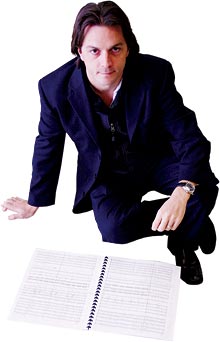When Valentine’s Day rolls around, the romantically inclined are drawn to certain tried-and-true measures. Roses, chocolates, and (if at all possible) a violinist bowing the soulful strains of some time-tested chestnut. “The Blue Danube,” perhaps, or “Hungarian Dance No. 1 in G minor.”

But if gazing into each other’s eyes over a swell of strings rings too close to Lady and the Tramp, that doesn’t mean the music is the problem. In fact, classical music encompasses some of the all-time most romantic material available. Seriously. Barry White was good, but he had nothing on the likes of French opera composer Jules Massenet and Austrian-born violinist and composer Fritz Kreisler.
However, not even Kreisler ranks among the artists represented in the Asheville Symphony’s Valentine’s Viennese Romance performance. That lineup (at least this go-around) is reserved for Johannes Brahms, Camille Saint-Saëns and Johann Strauss II.
“The era of the Strauss-family dynasty will forever mark Vienna as one of the leading exporters of romance,” explains Asheville Symphony musical director/conductor Daniel Meyer. “The waltz was considered the quintessentially seditious and lascivious dance, and the Viennese perfected it.”
If the idea of a waltz as wanton seems far-fetched, refer to any Jane Austen novel (try the wedding scene from Mansfield Park, where cousin-spouses Fanny and Edmund seal their union with a steamy spin) or the palpable onscreen chemistry in The Illusionist, set in Vienna’s golden age of music. Music in the 19th century, when Brahms, Saint-Saëns and Strauss were composing, was as much a form of art and entertainment as it was a screen for flirtation between couples who had little means to express their passions. And the concert selections tap into this passionate subterfuge.
“Not known for a heart-on-sleeve public persona, Johannes Brahms perhaps put his most emotionally direct orchestral music into his beloved Symphony No. 3,” say the notes for the concert.
It turns out that many of the classical world’s biggest stars had tabloid-ready lives. Rumor has it that, as a teen, Brahms helped supplement the family income by playing piano in brothels. His cello lessons ended abruptly when Brahms’ teacher stole the instrument. He carried on a lifelong (though likely platonic) affair with the wife of fellow composer Robert Schumann. Brahms himself never married.
“Brahms constantly strove to balance his music between the Apollonian and Dionysian,” Meyer says. “His sincere faith in craft led to his mastery of musical form and he created cohesive and direct musical arguments, but his sometimes-turbulent life and unrequited love for Clara Schumann always kept things interesting from an emotional standpoint.”
He adds, “We’re the happy beneficiaries today of this mix of passion and brains in his incredible music.”
The second featured composer, Johann Sebastian Strauss (aka Strauss the Younger, or Strauss Jr.), grew up in the shadow of his composer father. If that wasn’t enough, his brothers Josef and Eduard also carried on the family tradition. However, Strauss II’s fame surpassed that of his relatives, and he is thought to be largely responsible for the waltz craze in Vienna.
In the romance department, however, he was perhaps less successful. After the Roman Catholic Church denied him a divorce from his second wife (who was not supportive of his music), he changed religions. Happily, his third wife inspired such waltzes as “Kaiser Jubilaum” and “Märchen aus dem Orient.”
But even love’s pricklier side, as Strauss encountered in his early marriage, served as fodder for compositions. “There are so many works of art based on love found and lost that it’s not much of a stretch to put together a program that has a common thread based on romance or love,” Meyer notes.
The third featured composer, French-born pianist Saint-Saëns, seems to have had even less luck with romance. A child prodigy, he composed his first piece before age 4. He did marry, but he and his wife parted after only six years. Though they never divorced, they remained estranged, and in his late years, Saint-Saëns traveled extensively. He wrote about his journeys under the pen name “Sannois.” While in Vienna, he performed Beethoven’s “Piano Concerto No. 4” and conducted his own oratorio “Le Deluge.”
Though the three masters represented by the Asheville Symphony’s concert were at the top of their game during the 19th century’s golden age of the waltz, Meyer notes that classical music fans can also find romantic gems in contemporary offerings.
“The good news is that composers today are keenly aware of their audiences, and care if their music is played again,” Meyer says. “Now, composers like John Corigliano and Christopher Rouse are writing music about their own lives and loves, and they’re writing music with melody that you can actually follow.”
Some examples: Corigliano’s “Symphony No. 1” is dedicated to friends lost to AIDS; Rouse’s “Rapture” is inspired by a secret love.
Beyond that, the conductor suggests that listeners seek out their own favorites. “Start from a piece you love, and then trace forwards or backwards from there,” he recommends. “You don’t have to methodically traverse the style or historic periods. You can head straight for what you like, and your vistas will broaden rather quickly.”
who: Asheville Symphony Orchestra
what: Valentine’s Viennese Romance concert
where: Thomas Wolfe Auditorium
when: Saturday, Feb. 16. 8 p.m. ($17-$49 for adults. 254-7046)



Before you comment
The comments section is here to provide a platform for civil dialogue on the issues we face together as a local community. Xpress is committed to offering this platform for all voices, but when the tone of the discussion gets nasty or strays off topic, we believe many people choose not to participate. Xpress editors are determined to moderate comments to ensure a constructive interchange is maintained. All comments judged not to be in keeping with the spirit of civil discourse will be removed and repeat violators will be banned. See here for our terms of service. Thank you for being part of this effort to promote respectful discussion.